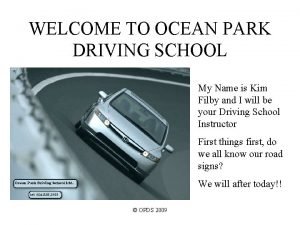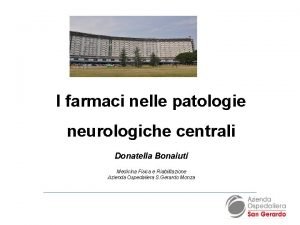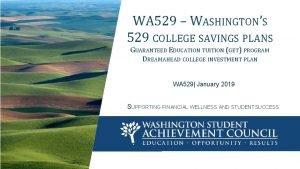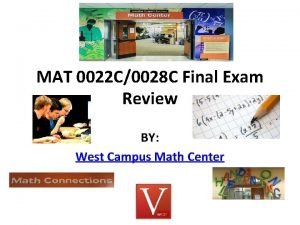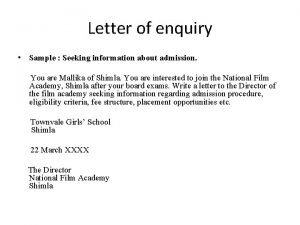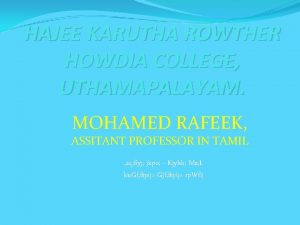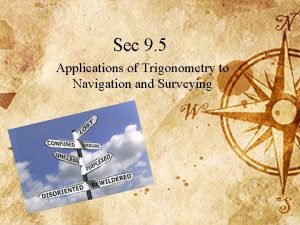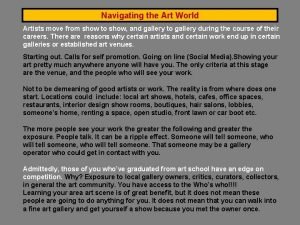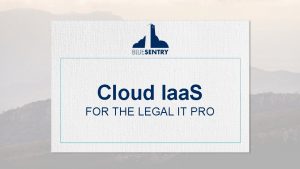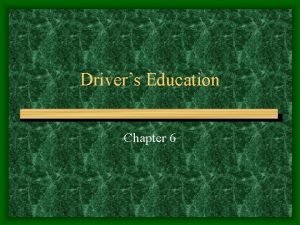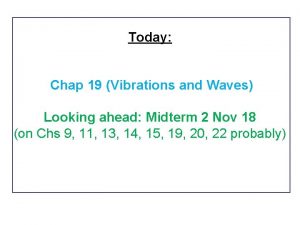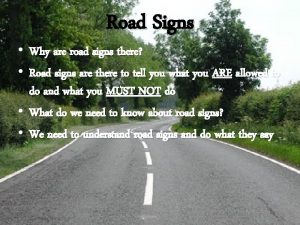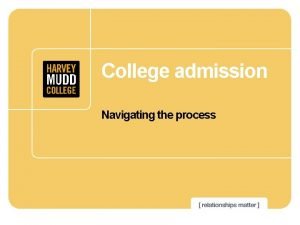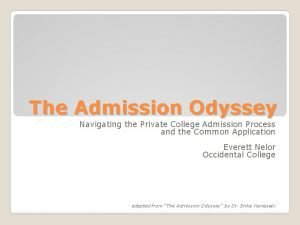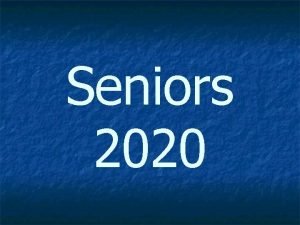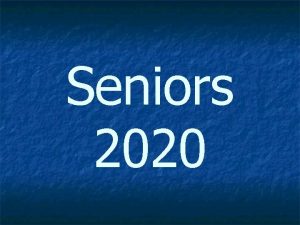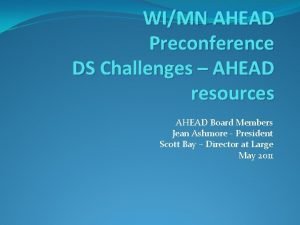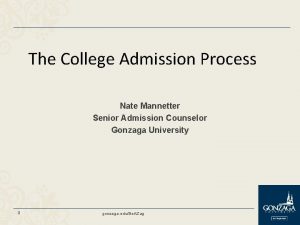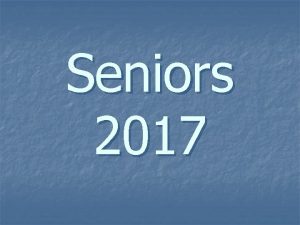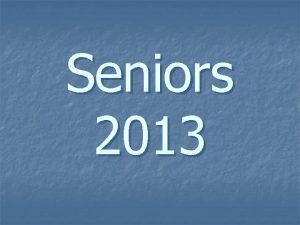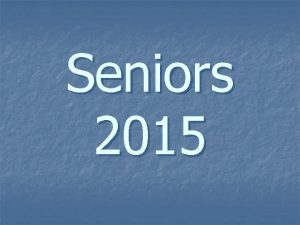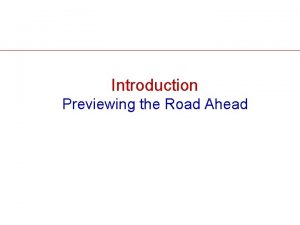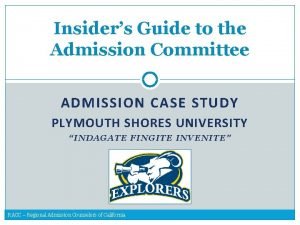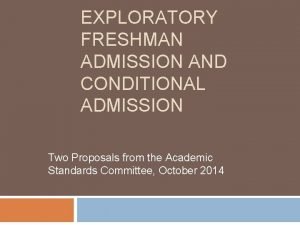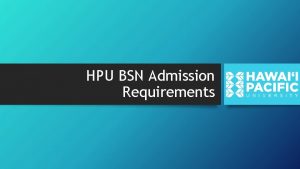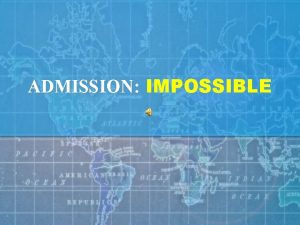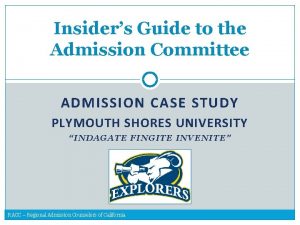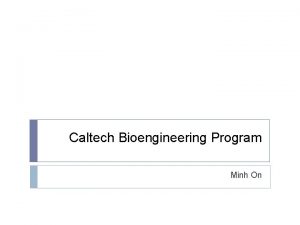THE ROAD AHEAD Navigating College Admission Tests Times


































































- Slides: 66

THE ROAD AHEAD Navigating College Admission Tests

Times Have Changed? • New York Times, “High School Seniors’ Agony”. . . “Competition for college admission has created an unprecedented time of intense worry. ” “Getting into college has never been so competitive. ” “Standards have shot up. Parents who got into top notch colleges on medium marks and good overall qualifications cannot understand why their kids can’t. ” . . . Written in 1957!

A New Sheriff in Town “I have a problem with the SAT. ” -David Coleman President, College Board Architect of the Common Core Standards

The SAT’s evolving mission • 1926: “The SAT is a psychological test designed primarily to assess aptitude for learning rather than mastery of subjects already learned, and to assess ability independently of any school curriculum. ” • 2005: “The SAT measures verbal and mathematical reasoning abilities that students develop over time, both in and out of school. ” • 2016: “The SAT must reflect the kinds of meaningful, engaging, rigorous work that students must undertake in the best high school courses being taught today, thereby creating a robust and durable bond between assessment and instruction. ”

Early History (1926 – 1959) • 1926: First SAT (8, 000 students) • 1937: First Achievement Tests (2, 000 students) • 1946: First SAT prep class • 1959: First PSAT • 1959: First ACT (to measure academic preparation; “achievement not aptitude”)

Middle History (1960 – 1994) • 1961: 800 K SATs (42%) and 300 K ACTs (16%) • 1968: UCs require the SAT • 1971: National Merit Scholarship begins • 1989: 1. 2 m SATs and 1 m ACTs • 1993: SAT drops “Aptitude” from its name

Recent History (1995 – 2010) • 1995: SAT scores are re-centered • 2001: UCs consider dropping the “esoteric” SAT • 2005: A “New” SAT debuts (2400 points) • 2007: Harvey Mudd accepts ACT (now ALL colleges accept both) • 2010: 1. 57 m ACTs and 1. 55 m SATs

The Latest News (2013 – 2016) • 2012: David Coleman (Common Core) becomes College Board president • 2013: Re-designed SAT announced • 2014: Pilot testing of vertically aligned testing systems (SBAC, PARCC) • 2015: New PSAT debuts • 2016: New SAT debuts (March)

Major Goals of the New SAT • More Focused • More In-depth • More Relevant • More Transparent

Philosophical Shifts of the New SAT • Shares many of the Common Core guiding ethics • Adopts many of ACT’s characteristics • Now more than ever, tests achievement over aptitude

Highlight Changes of the New SAT • • Returns to the 1600 -point scale Guessing penalty eliminated Shorter (but not really) Calculator and non-calculator sections Essay is optional Command of Evidence is emphasized Text-heavy; reading-centric Source Material; non-fiction emphasis

Scoring the Redesigned SAT

Holistic Review (but some things matter more) 94% Grades in college prep courses 90% Strength of curriculum 87% Grades in all courses 87% Standardized test scores 59% Teacher and counselor recommendations 58% Essay or writing sample 50% Class rank 49% Student’s demonstrated interest 46% Extracurricular activities 34% AP/IB scores

Mixed Messages • Alumni magazine, August 2014: “Selectivity on the rise…record-low 21% of applicants received the coveted ‘thick envelopes’… 2000 more applications than prior year…from more diverse backgrounds…” ---and--“…the students are also SMARTER, with a mean SAT score 18 points higher than last year’s crop”

Application Bubble College Applications - % Submitted One application Four or more applications 60 50 40 30 20 10 0 1967 1976 1986 1996 2006

Higher GPA = Less Differentiation Percent of Students 1991 2013

Score Distribution: By Design

SAT Scoring: Relative Standing Cumulative Percentiles SAT COMBINED SCORE

1 11 16 21 26 31 99. 9 th percentile 95 th percentile 80 th percentile 50 th percentile What Does My Score Mean? ACT 36

Pathways to College Admission • SAT only or ACT only (2, 000+ schools) • SAT or ACT, plus Subject Tests (~ 10 -40 schools) • Test Optional/Flexible (~ 50 schools) [p. 4 -6] Page 3

Standardized Test Checklist • New PSAT • Old SAT vs. New SAT vs. ACT • Subject Tests • Timelines & Preparation • Repeat Testing & Score Choice

Strategic Planning Evaluate pros and cons of the three options Seek out diagnostic test opportunities, especially ACT Don’t overlook Subject Tests Follow best practices around timing and formal preparation

PSAT Structure: 2014 vs. 2015 2014 2015 Scoring 20 to 80 (x 3) 160 to 760 (x 2) Time 2 hours 10 minutes 2 hours 45 minutes Items 125 138 Reading 48 items | 50 min 47 items | 60 min Writing 39 items | 30 min 44 items | 35 min Mathematics 38 items | 50 min 47 items | 70 min Wrong Answers ¼ point deduction No deduction

Vertical Alignment of Scales

National Merit and the PSAT

Three choices (two are compromised) ① “Old” SAT – – Discontinued as of Jan 2016 Accelerated timeline is inappropriate for most ② “New” SAT – – – Practice tests limited and in “beta” form Predicted scores highly speculative Scores delayed until late spring 2016 ③ Current ACT – – – Deep bank of practice tests available Prep materials and offerings are well-established All test dates available with prompt reporting of scores

Traditional Testing Sequence 1. October of 11 th grade PSAT (NMSQT) 2. March (or May) of 11 th grade SAT or Feb (or April) of 11 th grade 3. May or June of 11 th grade 4. Fall of 12 th grade ACT Subject Tests Re-test as necessary Page 8 -9

Class of 2017’s Likely Testing Sequence 1. October of 11 th grade New PSAT (NMSQT) 2. March (or May) of 11 th grade SAT Feb (or April) of 11 th grade ACT 3. May or June of 11 th grade 4. Fall of 12 th grade ✔ Subject Tests Re-test as necessary (ACT, SAT) Page 8 -9

Rise of the ACT Nationally 2013 SAT Takers 1. 7 Million ACT Takers 1. 8 Million • Number of students taking the ACT has increased by 30% since 2008

Rise of the ACT in California • ACT has grown 126% in California* over last decade • In 2013 in CA there were still more SAT-takers, but the gap is closing fast • Number of students scoring 32 -36 on ACT has increased by 70% since 2010 – * HS graduates are up 9%

Rise of the ACT at Compass (SF & LA) 100% 90% 80% 70% 60% 50% SAT 40% ACT 30% 20% 10% 0% 2005 2006 2007 2008 2009 2010 2011 2012 2013 2014 2015

ACT Science: Data Analysis Structure • • 40 questions in 35 minutes 6 -7 passages: Data Representation, Research Summary, Conflicting Hypotheses 5 -7 questions per passage Contains little to no Science content; focuses on methodology and data analysis Pacing Concerns • Average of 5 -6 minutes per passage, to both read answer • Difficulty ascends from passage to passage and on questions within passages • Some passages will likely be harder than others, thus requiring more time • Questions almost always refer to specific components of the passage Average percentage of students who skipped any given question in… Passage 1: 1% Passage 2: Passage 3: Passage 4: Passage 5: Passage 6: Passage 7: 1% 1% 2% 5% 8% 11%

Concordance Table: Current SAT – ACT Composite SAT CR+M+W 36 35 34 33 32 31 30 29 28 27 26 25 24 23 2390 2330 2250 2180 2120 2060 2000 1940 1880 1820 1770 1710 1650 1590

Current SAT: “Aptitude” Math 17. Four distinct lines lie in a plane, and exactly two of them are parallel. Which of the following could be the number of points where at least two of the lines intersect? I. Three II. Four III. Five (A) I only (B) III only (C) I and III only (D) I, II, and III (E) It cannot be determined from the information given.

ACT: “Achievement” Math (x-h)2 + (y-k)2 = r 2 Center: (h, k) Which of the following is an equation of a circle with its center at (3, 4) and tangent to the x-axis in the standard (x, y) coordinate plane? A. B. C. D. E. (x - 3)2 + (y - 4)2 = 16 (x - 4)2 + (y - 3)2 = 9 (x - 3)2 + (y - 4)2 = 9 (x + 4)2 + (y + 3)2 = 16 (3, 4) 4

Thematic Features of the New SAT Math An international bank issues its Traveler credit cards worldwide. When a customer makes a purchase using a Traveler card in a currency different from the customer’s home currency, the bank converts the purchase price at the daily foreign exchange rate and then charges a 4% fee on the converted cost. Sara lives in the United States, but is on vacation in India. She used her Traveler card for a purchase that cost 602 rupees (Indian currency). The bank posted a charge of $9. 88 to her account that included the 4% fee. • Contains both Calculator and Non. Calculator sections • Focuses more heavily on Algebra and Data Analysis, with some attention to Trigonometry PART 1 • Involves real world applications of concepts, including a progression of problems building off of a given scenario PART 2 What foreign exchange rate, in Indian rupees per one U. S. dollar, did the bank use for Sara’s charge? Round your answer to the nearest whole number. A bank in India sells a prepaid credit card worth 7, 500 rupees. Sara can buy the prepaid card using dollars at the daily exchange rate with no fee, but she will lose any money left unspent on the prepaid card. What is the least number of the 7, 500 rupees on the prepaid card Sara must spend for the prepaid card to be cheaper than charging all her purchases on the Traveler card? Round your answer to the nearest whole number of rupees.

Thematic Features of the New SAT Vocabulary • Focuses on Tier 2 words “The nature of impeachment: a narrowly channeled exception to the separation of powers maxim. The Federal Convention of 1787 said that. ” • Exploits words with multiple meanings 3. As used in line 37, “channeled” most nearly means • Challenges students to derive meaning from the context in which words are used A) worn. B) sent. C) constrained. D) siphoned.

Thematic Features of the New SAT The United States Bureau of Labor Statistics forecasts steady job Text & Data growth in this field, ⁶projecting that 16 percent of new jobs in all occupations will be related to urban and regional planning. Percent Increase in Employment, Projected 2010 -2020 Social Scientists • Permeates all sections of the test Urban and Regional Planners • • Requires students to analyze and extrapolate from data represented graphically in multiple contexts Asks students to identify and correct inconsistencies between data and text Total 0 5 Percent 15 10 20 6. Which choice completes the sentence with accurate data based on the graph? A) NO CHANGE B) warning, however, that job growth in urban and regional planning will slow to 14 percent by 2020. C) predicting that employment of urban and regional planners will increase 16 percent between 2010 and 2020. D) indicating that 14 to 18 percent of urban and regional planning positions will remain unfilled.

Thematic Features of the New SAT Citing Evidence • Spans all sections of the test, including Math • Requires students to support their answer choices • Challenges students to explain how an author uses evidence to craft an argument 4. In lines 49 -54 (“Prosecutions … sense”), what is the most likely reason Jordan draws a distinction between two types of “parties”? A) To counter the suggestion that impeachment is or should be about partisan politics 5. Which choice provides the best evidence for the answer to the previous question? A) Lines 13 -17 (“It…office”) B) Lines 20 -24 (“The division…astute”) C) Lines 55 -58 (“The drawing…misdemeanors”) D) Lines 65 -68 (“Congress…transportation”)

Thematic Features of the New SAT Grammar • Requires students to revise extended prose to more accurately express an author’s intent • Addresses a wider range of punctuation • Tests frequently confused words such as allusion/illusion During his career, Kingman exhibited his work ⁷ internationally. He garnered much acclaim. In 1936, a critic described one of Kingman’s solo exhibits as “twenty of the freshest, most satisfying water colors that have been seen hereabouts in many a day. ” 7. Which choice most effectively combines the sentences at the underlined portion? A) internationally, and Kingman also garnered B) internationally; from exhibiting, he garnered C) internationally but garnered D) internationally, garnering

Current SAT Essay: (through January 2016) • First Section. 25 minutes. Required. • Ex: “Can people choose to be happy? ” • Personal experience ok • Thesis can be only tangentially related to topic • Graded holistically, rewards style • Widely criticized • Held in low regard by colleges

Current ACT Essay: (through June 2015) • Last section. 30 minutes. Optional* • Ex: “Should students have to wear uniforms? ” • Graded on persuasiveness of argument • Creativity and style not necessarily rewarded • Held in low regard by colleges

New ACT Essay: (as of September 2015) • Expected to increase to 40 minutes • Will require evaluation of three different perspectives on a topic, e. g. artificial intelligence • Students must not only present their own perspective but also analyze the perspectives given • Essays receiving high scores will “effectively employ rhetorical strategies”

Thematic Features of the New SAT Essay • Is based on a common prompt • Measures students’ ability to explain how an author crafts an argument • Rates students on strength of analysis and coherence of writing As you read the passage below, consider how Paul Bogard uses • evidence, such as facts or examples, to support claims. • reasoning to develop ideas and to connect claims and evidence. • stylistic or persuasive elements, such as word choice or appeals to emotion, to add power to the ideas expressed. [650 -750 word Source Text will appear here] Write an essay in which you explain how Paul Bogard builds an argument to persuade his audience that natural darkness should be preserved. In your essay, analyze how Bogard uses one or more of the features listed in the box above (or features of your own choice) to strengthen the logic and persuasiveness of his argument. Be sure that your analysis focuses on the most relevant features of the passage. Your essay should not explain whether you agree with Bogard’s claims, but rather explain how Bogard builds an argument to persuade his audience.

SAT Subject Tests Designed to demonstrate academic achievement in specific subject areas Scored on 200 -800 scale 1 hour each, can take up to 3 subjects in one sitting Plan ahead to maximize scores Recommended? Required? How many? Which ones?

Subject Test Policies UC system no longer requires Subject Test scores but will consider them if submitted No longer any college requiring 3 Subject Tests Georgetown still “recommends” 3 ~30 colleges officially require 2 Many colleges “recommend” 2 Detailed list at www. subject-tests. com

SAT Subject Test Options Literature U. S. History or World History Math Level 2 or Math Level 1 Biology (E/M), Chemistry, and Physics Languages: French, Chinese, German, Spanish, Modern Hebrew, Italian, Japanese, Korean, and Latin

Test Scoring: US History Raw score Scaled score 81 - 90 800 70 740 60 680 55 650 50 620 45 590 40 560 35 530 30 510

REPEAT TESTING

Multiple Scores Public Private Superscore 52% 61% Best Sitting 41% 25% Most Recent Sitting 2% 5% Average of All Scores 1% 1% No Response 4% 7%

Questions Remain Colleges’ reactions and policy changes • Essay (UC’s will require it) • Score Choice • super-scoring Concordance with old SAT scores and with ACT scores More changes in the future: Subject Tests, ACT

Score Choice – Varying Policies Harvard – We allow Score Choice – “The application is yours. We’ll review what you send us. ” Georgetown – We don’t allow Score Choice under any conditions or combinations – And we require three Subject Tests (yep, just us) Stanford – You can’t use Score Choice for SAT or ACT; all of both must be sent – Score Choice is allowed for Subject Tests, because they’re optional* Yale – Choose either a) SAT + ST’s or b) ACT alone, then send all of either – If you choose to send ST’s with ACT, then you must send all SAT’s too

SUPERSCORING March SAT October SAT Critical Reading 600 Reading 650 Math 600 Writing 550 Writing 600 Combined 1850 Superscored SAT Reading Math Writing Combined 1900

The Big Takeaways Focus on reading now Consider Subject Test(s) and/or AP(s) sophomore spring Take diagnostic test(s) early summer after sophomore year Decide when and how you will prepare Maintain perspective

A REALITY CHECK

A REALITY CHECK

A REALITY CHECK

A REALITY CHECK

A REALITY CHECK

A REALITY CHECK

Q & A… Southern California 226 South Beverly Drive Suite 200 Beverly Hills, CA 90212 (800) 925 -1250 Northern California 700 Larkspur Landing Circle Suite 235 Larkspur, CA 94939 (415) 464 -8600

Access to Practice Test Opportunities Connect with Compass to find dates & locations, reserve a seat, or receive guidance: • Complete tear-off card and return to me • Visit po. st/compass and complete quick-form • Call 415 -464 -8600 Page 48 -49

Subject Tests make sense for high scorers. . . Math Level 2 Subject Test Takers in California 2009 All Scorers 700 -800 Scorers ~ 67, 000 ~ 13, 000 2013 All Scorers 700 -800 Scorers ~ 35, 000 ~ 13, 000 Most schools that look for students in the 500 -650 range don’t require or use Subject Tests

READING COMPREHENSION EXAMPLE But these advantages come at a price: the Internet appears to be chipping away at my capacity for concentration and contemplation. My mind now expects to take in information the way the Internet distributes 11 it, in a swiftly moving stream of particles. Once I was a scuba diver in the 12 sea of words. Now I zip along the surface like a person on water skis. attractor The figure of speech in lines 11 -12 (“Now. . . skis”) serves primarily to 37% (A) emphasize the speed of the Internet (B) underscore the vastness of the Internet (C) convey the sense of control that the author feels 49% (D) suggest the cursory nature of the author’s thinking process (E) highlight the author’s fascination with high-speed activities

SCORE CHOICE POLICIES SAT – You can select which dates to send, but you cannot send sub-scores (CR, M, or Wr) only – Most private colleges combine sub-scores from multiple sittings, while most public colleges do not ACT – Same as SAT, except there are few colleges who officially combine subscores from multiple sittings Subject Tests – You select which individual scores to send

Subject Test Takers, by the numbers: USA California 2009 1. 53 million SATs 207, 000 SATs 295, 000 STs ( ~ 20%) 107, 000 STs ( ~ 50%) 2012: UCs dropped their ST requirement 2013 1. 66 million SATs 234, 000 SATs 251, 000 STs ( ~ 15%) 56, 000 STs ( ~ 20%)
 Road branching off ahead
Road branching off ahead Donatella bonaiuti
Donatella bonaiuti Alabama road signs and meanings
Alabama road signs and meanings Ace different tests help iq tests
Ace different tests help iq tests Dreamahead vs get
Dreamahead vs get Factors of 168
Factors of 168 Letter of enquiry
Letter of enquiry Hajee karutha rowther howdia college admission
Hajee karutha rowther howdia college admission Tarrant county college admission requirements
Tarrant county college admission requirements What is paved and unpaved road
What is paved and unpaved road Math bearings
Math bearings Navigating the body muscular system #2
Navigating the body muscular system #2 Navigating the art world
Navigating the art world Amazon aws gdpr
Amazon aws gdpr Navigating the digital landscape
Navigating the digital landscape Navigating gdpr compliance on aws
Navigating gdpr compliance on aws What is the purpose of liquid in the capsule of a compass?
What is the purpose of liquid in the capsule of a compass? Thế nào là sự mỏi cơ
Thế nào là sự mỏi cơ Trời xanh đây là của chúng ta thể thơ
Trời xanh đây là của chúng ta thể thơ Phản ứng thế ankan
Phản ứng thế ankan Gấu đi như thế nào
Gấu đi như thế nào Thiếu nhi thế giới liên hoan
Thiếu nhi thế giới liên hoan Vẽ hình chiếu vuông góc của vật thể sau
Vẽ hình chiếu vuông góc của vật thể sau điện thế nghỉ
điện thế nghỉ Một số thể thơ truyền thống
Một số thể thơ truyền thống Thế nào là hệ số cao nhất
Thế nào là hệ số cao nhất Ng-html
Ng-html Sơ đồ cơ thể người
Sơ đồ cơ thể người Bảng số nguyên tố
Bảng số nguyên tố đặc điểm cơ thể của người tối cổ
đặc điểm cơ thể của người tối cổ Cách giải mật thư tọa độ
Cách giải mật thư tọa độ Các châu lục và đại dương trên thế giới
Các châu lục và đại dương trên thế giới Glasgow thang điểm
Glasgow thang điểm ưu thế lai là gì
ưu thế lai là gì Thẻ vin
Thẻ vin Tư thế ngồi viết
Tư thế ngồi viết Cái miệng nó xinh thế chỉ nói điều hay thôi
Cái miệng nó xinh thế chỉ nói điều hay thôi Các châu lục và đại dương trên thế giới
Các châu lục và đại dương trên thế giới Từ ngữ thể hiện lòng nhân hậu
Từ ngữ thể hiện lòng nhân hậu Bổ thể
Bổ thể Tư thế ngồi viết
Tư thế ngồi viết Thế nào là giọng cùng tên? *
Thế nào là giọng cùng tên? * Thơ thất ngôn tứ tuyệt đường luật
Thơ thất ngôn tứ tuyệt đường luật Chúa sống lại
Chúa sống lại Khi nào hổ con có thể sống độc lập
Khi nào hổ con có thể sống độc lập đại từ thay thế
đại từ thay thế Diễn thế sinh thái là
Diễn thế sinh thái là Vẽ hình chiếu vuông góc của vật thể sau
Vẽ hình chiếu vuông góc của vật thể sau Phép trừ bù
Phép trừ bù Công thức tiính động năng
Công thức tiính động năng Tỉ lệ cơ thể trẻ em
Tỉ lệ cơ thể trẻ em Thế nào là mạng điện lắp đặt kiểu nổi
Thế nào là mạng điện lắp đặt kiểu nổi Lời thề hippocrates
Lời thề hippocrates Vẽ hình chiếu đứng bằng cạnh của vật thể
Vẽ hình chiếu đứng bằng cạnh của vật thể Quá trình desamine hóa có thể tạo ra
Quá trình desamine hóa có thể tạo ra Môn thể thao bắt đầu bằng chữ đua
Môn thể thao bắt đầu bằng chữ đua Hát kết hợp bộ gõ cơ thể
Hát kết hợp bộ gõ cơ thể Sự nuôi và dạy con của hổ
Sự nuôi và dạy con của hổ Dạng đột biến một nhiễm là
Dạng đột biến một nhiễm là Forgetting those things that are behind me
Forgetting those things that are behind me To steer straight forward, look:
To steer straight forward, look: Exciting year ahead
Exciting year ahead Ahead ea wall
Ahead ea wall Cycle route ahead sign
Cycle route ahead sign Red over red the captain is dead
Red over red the captain is dead Getting ahead
Getting ahead Ahead section
Ahead section
